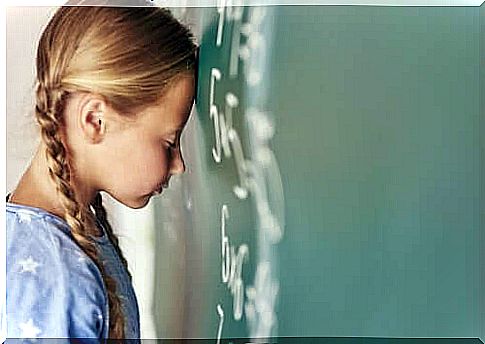Acalculia, The Inability To Understand Numbers

Imagine for a moment that you could not understand numbers and calculations as simple as 2 or 2 + 2. This condition of mathematical skills, known as acalculia, was discovered by neurologist Salomon Henschen in 1925. It continues to do so. intrigue the world of science so far.
What if we told you that an area of your brain is responsible for mathematical calculations? It would be like having a built-in calculator, right? Acalculia is a deficit that directly affects the ability to calculate due to an acquired brain injury.
The different types of acalculia
Acalculia can be divided into two large groups according to the capacities affected and the areas injured. As a rule, the affected hemisphere is the left, responsible for logical reasoning. Likewise, the classification of acalculia will depend on both the area of the left hemisphere affected and the degree to which skills are affected.

Primary acalculia
Primary acalculia is a defect in calculus skills unrelated to other disorders. Patients lose the ability to understand digital concepts and therefore to combine them.
The main errors are noticed during the execution of operations and in a more abstract way, by the use and the interpretation of the signs. Lesions are associated with the frontal lobe of the left hemisphere. This lobe is considered to be the conductor of our brain. This is why its alteration leads to the inability to alternate mathematical concepts. We can thus differentiate two concrete symptoms of primary acalculia:
- Anarithmetic: The inability to perform arithmetic calculations
- Asyntactic: the loss of the computionnalist sense
The secondary acalculia
Secondary acalculia is the alteration of mathematical skills in association with other neurological disorders. Thus, secondary acalculia can arise from a linguistic, spatial and executive function deficit in general. In summary, we can group them into the following subcategories:
- Aphasic acalculia: the defects in the calculation come from linguistic alterations. The inability to understand and codify numeral language results in an inability to process it
- Alexic acalculia: it is mainly linked to problems of reading and recognizing numeral symbolics. The patient cannot understand through reading
- Agraphic acalculia: agraphia consists of the inability to communicate and express oneself through writing. Said disorder does not come from the inability to perform the movement but from the incomprehension of the act of writing at the symbolic level. Therefore, the patient is unable to write numbers
- Frontal acalculia: this is perhaps the most common form of acalculia. It is closely linked to attention disorders. These patients tend to persevere and therefore repeat mistakes systematically. This condition is due to the inability to identify errors and think of other strategies to arrive at the solution.
- Semantic acalculia: the person affected by this type of acalculia has difficulty using relationship concepts. A clear example would be the inability to associate mathematical problems with the operations necessary for its solution.
- Spatial acalculia: this is an anomaly of the right hemisphere. The difficulty in performing arithmetic calculations is associated with problems in spatial processing
How is primary acalculia diagnosed ?
The most important thing is to observe that the symptoms manifest themselves both orally and in writing. Primary acalculia consists of a loss of the digital concept. This can sometimes be confused with different aphasic symptoms. It is necessary to verify that the deficit is due to the loss of the concept and to an error in the verbal comprehension of the instructions.
Why do patients with frontal lesions fail in digital operations?
First of all, solving numerical operations requires a plane in which several mathematical concepts are integrated. To solve an addition, for example, you have to understand the principle of additivity. Second, most math problems require abstract reasoning. The lack of inhibition in syndromes peculiar to frontal lesion hinders this process by difficult concentration.
Finally, selective attention as well as the sequential integration necessary for performing digital operations are disrupted by the slightest integration of visual and / or auditory stimuli. As we mentioned before, the frontal lobe is the conductor of the brain. If it shows deficits, it will be more complicated to arrange the information in a way that favors the resolution of the problem.

Acalculia and other conditions
We can notice acalculia in aphasic subjects since their language skills are affected. In the context of Broca’s aphasia, for example, the deficit manifests itself in the syntax applied to the calculus. In the case of alexic acalculia, on the other hand, the deficit is linked to difficulties in reading.
A more telling example is pure alexia, where the difficulties in carrying out a verbal and literal interpretation of written language are noticed in the erroneous interpretation of numbers, magnitudes and hierarchies.
Other ways to detect acalculia
In the context of agraphia, acalculia may appear to be related to the inability to write quantities. Thus, the type of acalculia will depend on the type of agraphia.
In Wernicke’s aphase, for example, the patient exhibits errors in copying dictated numbers. To compensate for this challenge in verbal comprehension, patients often invent the numbers and assign them their own order.
Treatment of acalculia
First you have to understand that it is a very different disorder from dyscalculia. The latter is a problem of development and learning. Therefore, it requires other strategies to treat it. As for acalculia, its diagnosis is often made by neuropsychologists, thanks to several examinations. The person must for example perform mental arithmetic operations, written, successive operations, the interpretation of arithmetic signs and the alignment of numbers in columns.
Treatment for primary acalculia will depend on the type of injury and its severity. Due to the inability of lost nerve tissue to recreate itself, rehabilitation often has one goal: to teach new strategies based on neuroplasticity.
Although recovery will never be complete, the patient must be provided with tools that will improve their adaptation. Also, treatment for secondary acalculia will vary depending on the associated disorder. Advances in technology bring computer tools and applications that represent hope for patients.










